the Renaissance of the Car
by Scott Huler
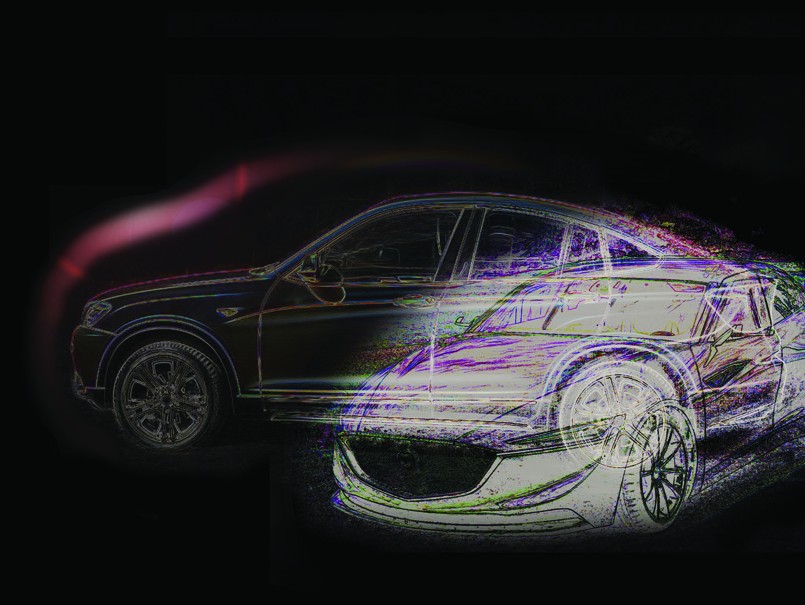

Imtiaz Haque: After one hundred years, we’re redefining the car. Photo by Ashley N. Jones.
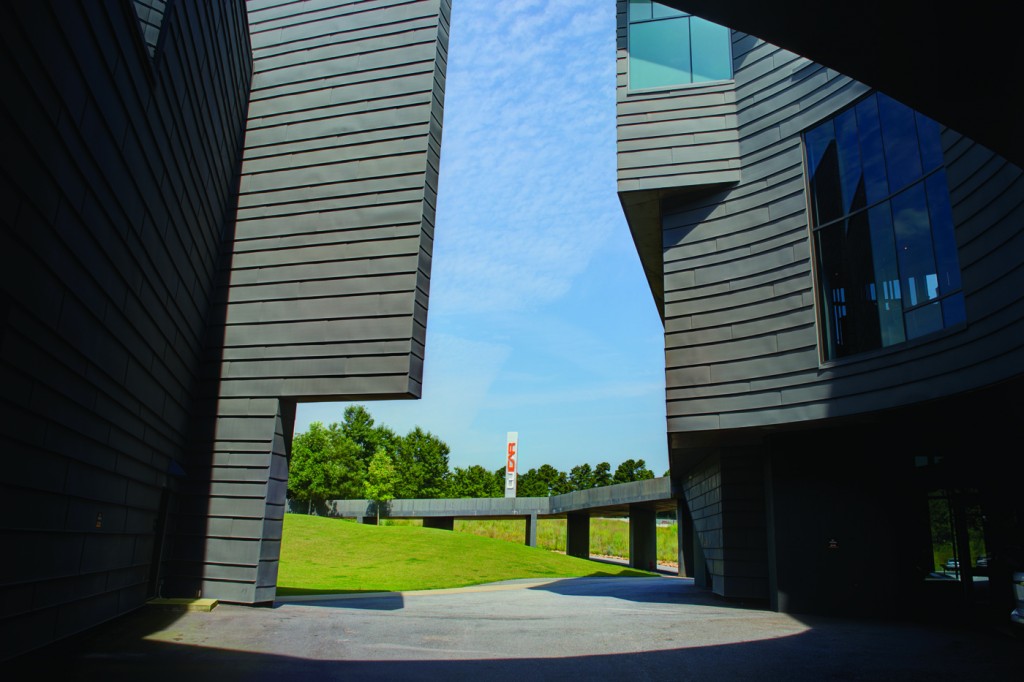
Clemson’s International Center for Automotive Research is a 250-acre research campus where university, industry, and government partners collaborate using industrial-scale laboratories and testing equipment. The campus also supports graduate education in automotive engineering. Photo by Ashley N. Jones.


Revving up a renaissance
Zoran Filipi (right) and a colleague, Robert Prucka, discuss results from vehicle-exhaust emissions testing in CU-ICAR’s chassis dynamometer facility, where researchers can assess the impact of new technologies on fuel economy and emissions. Filipi says the car as we know it is about to change, and change big. “That’s why it’s so exciting,” he says. “That’s why people talk about a renaissance.” Photo by Patrick Wright.
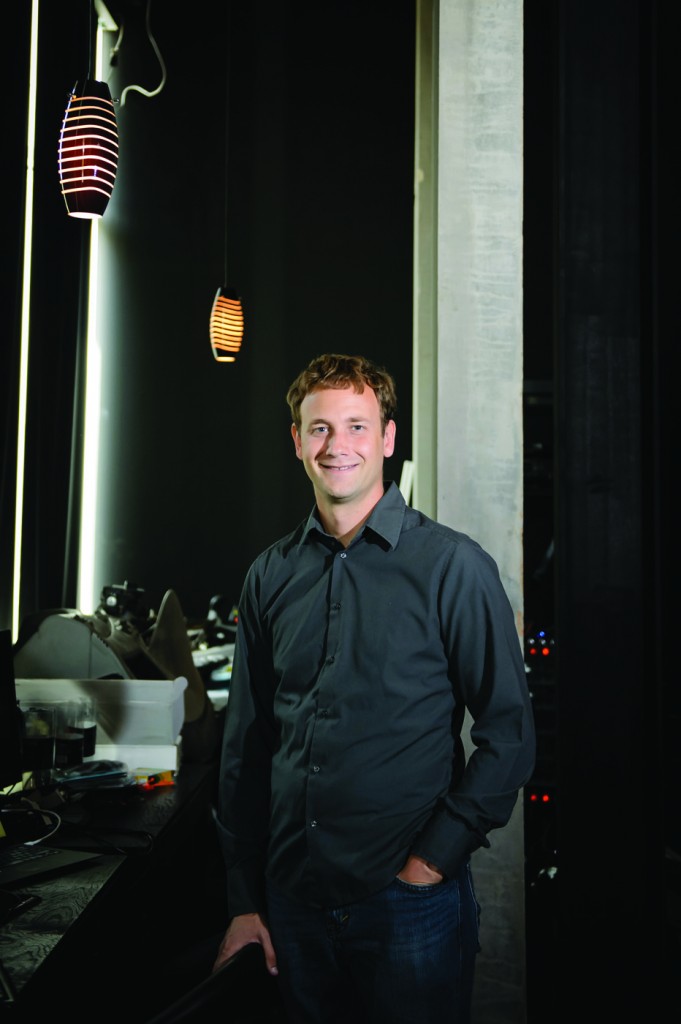
What will you be doing, if the car drives itself?
What will we do with our time in the car, if we don’t have to drive it? As he develops software and vehicle designs, David Smith is looking for ways to go beyond simple navigation and “augment reality” in the human-computer interface that operates the autonomous car. “You get people that time back from when they were in their car driving places, to do more productive things,” he says. Photo by Ashley N. Jones.

Smith and his Ph.D. student, Andreas Kasprzok, are developing an interactive dash software system. Photo by Ashley N. Jones.

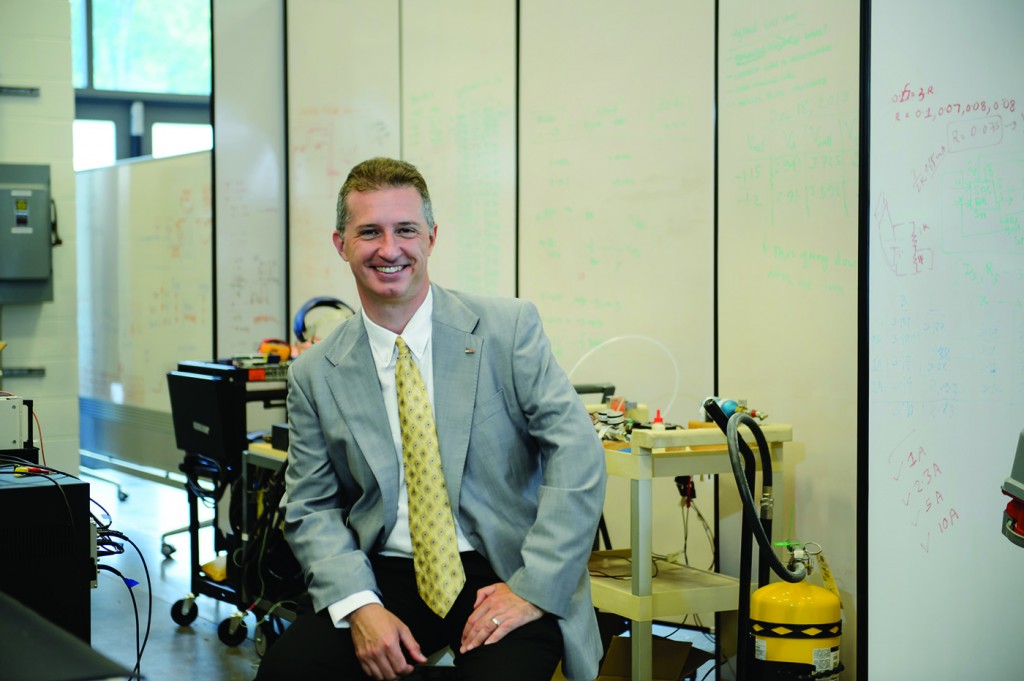
Driven by data
Pierluigi Pisu says technology has brought us very close to autonomous vehicles—cars that drive themselves. But the sensors and computing power required to operate a moving vehicle and to manage its safety, road fitness, and fuel economy are expensive and complex. “It requires deep knowledge of what the data mean,” he says. Photo by Ashley N. Jones.

Retooling the tools
Laine Mears develops ways to machine new materials for the next generation of vehicles. The goal, he says, is to make manufacturing plants as nimble as the cars need to be. “The car I’m building today is not going to be the car I’m building tomorrow,” he says. Photo by Ashley N. Jones.
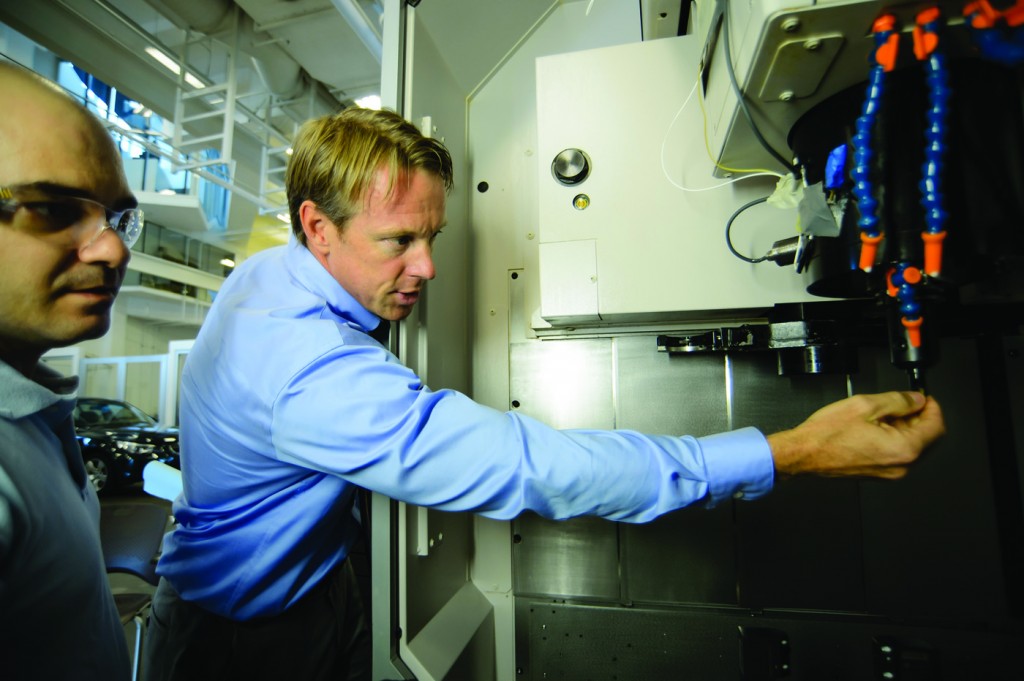
Vassilis Bardis, a Ph.D. graduate research assistant, helps Mears investigate how tools react to different materials in manufacturing. Photo by Ashley N. Jones.
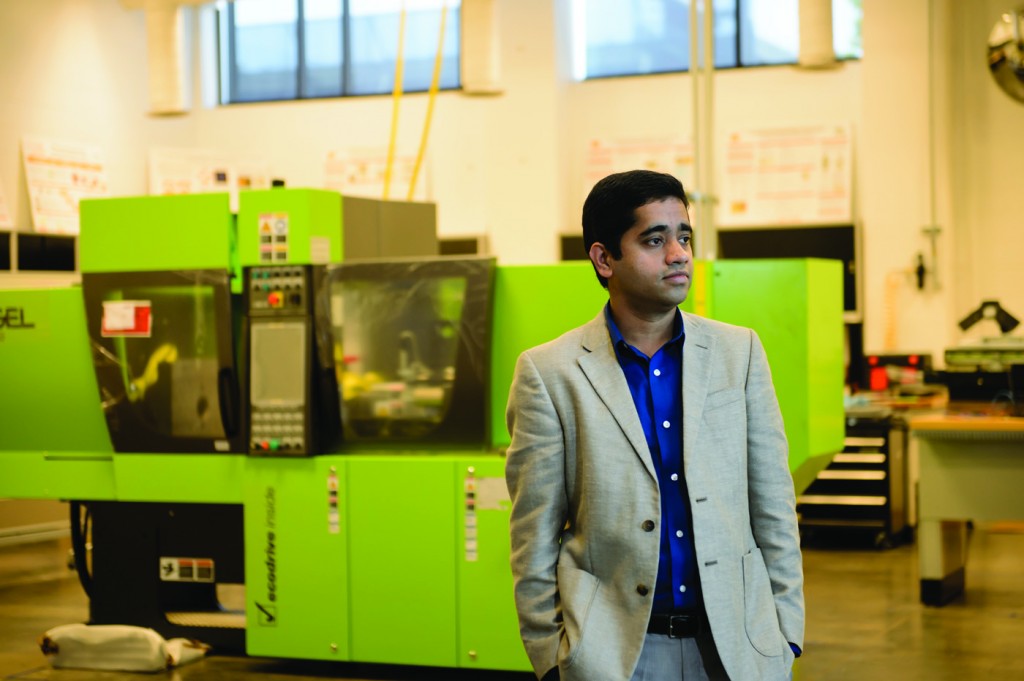
Greener and lighter
Srikanth Pilla uses this big green machine (a supercritical fluid-assisted microcellular injection molding machine) to fabricate structural foams from environmentally benign gases, creating seat panels, dashboards, and other parts that have greater strength with less weight than conventionally molded components. In bioplastics, bacteria can help build a car and shrink its carbon footprint. Photo by Ashley N. Jones.

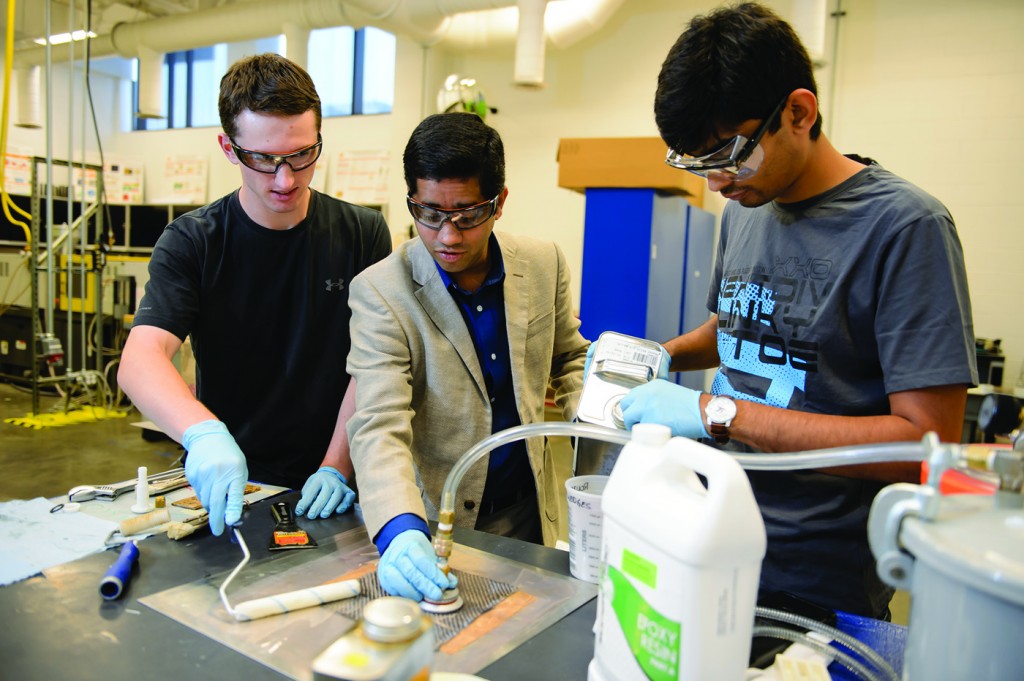
Kelly Krumm, an undergraduate research intern, and Sohil Shah, a master’s student, work with Pilla to set up a vacuum infusion process to fabricate thermoset composites reinforced with natural fibers. Photo by Ashley N. Jones.

Help behind the wheel
Johnell Brooks finds ways to keep people safe on the road. Photo by Neil Caudle.
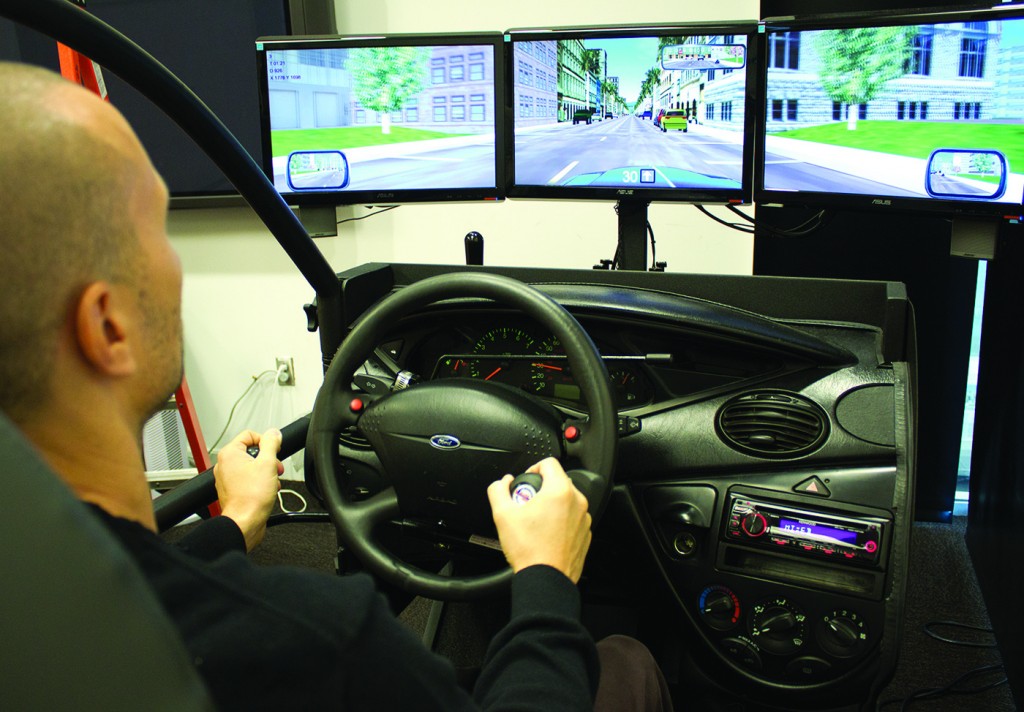
Johnell Brooks’ simulator, with its realistic road scenes, enables drivers who are adjusting to injury or age to learn new skills before they try them in traffic. Human factors also guide the engineers who design new vehicle systems. Photo by Neil Caudle.

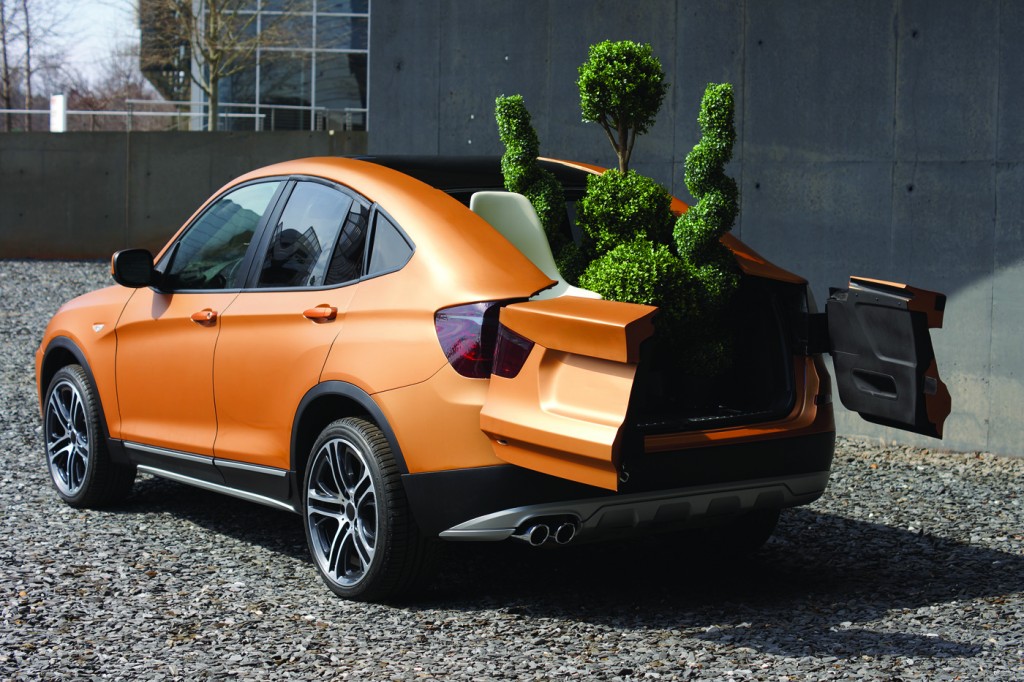
Open to the bright idea
Deep Orange 4, with flexible cargo space and a sporty design aimed at a niche market of performance-minded SUV customers, debuted August 4 at an industry briefing in Traverse City, Michigan. Sponsored by BMW Manufacturing Company, the vehicle is based on the BMW X3 reconceived by Clemson students, who developed a cost-efficient manufacturing plan detailing how a low-volume model could be assembled without disrupting existing BMW production processes.
“The ability to integrate more low-volume models without incurring capital-intensive retooling costs and efficiency losses will be key to success in the future as we strive to respond to changes in market needs faster and with more flexibility,” says Rich Morris, vice president of assembly, BMW Manufacturing. “The students working on this phase of the project did an excellent job of keeping costs down while finding optimal integration opportunities.” Image courtesy of CU-ICAR.
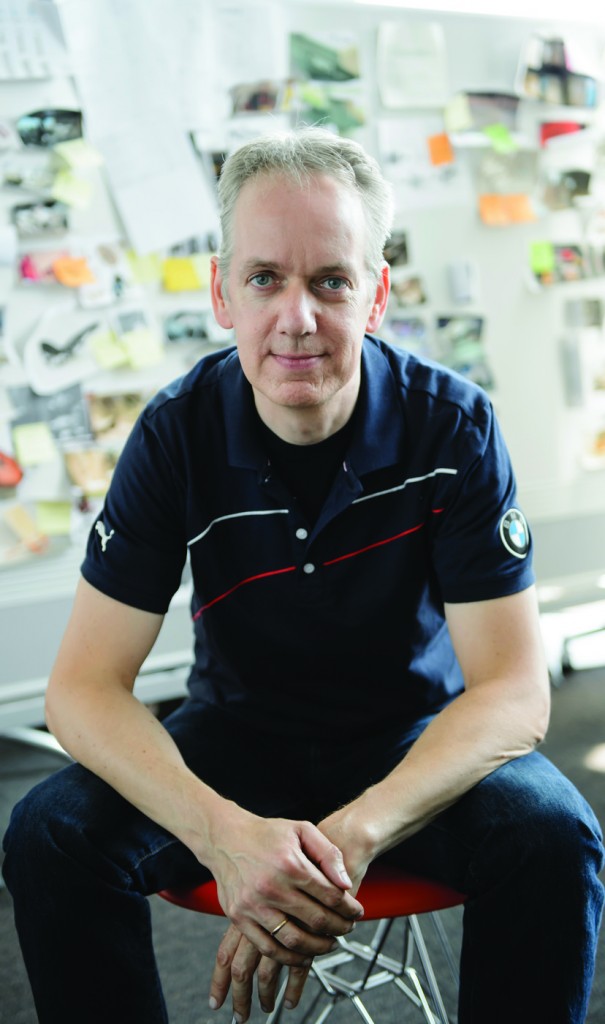
Paul Venhovens leads the Deep Orange program. His students’ next project, Deep Orange 5, in partnership with General Motors, is under way and under wraps at the CU-ICAR lab. “We start with a white sheet of paper,” he says, “to expose the world to different thinking.” Image courtesy of CU-ICAR.
Ever since that flying police officer said, “All right, buddy, where’s the supernova?” when he stopped George Jetson for speeding in a space-age bubble car, we’ve all known: The car is dying. It won’t be around long. It will turn into flying hemispheres, or supertrains, or moving sidewalks, or jetpacks, or some kind of teleportation device. The car is a transition technology to…whatever’s next. We know this. The car is doomed.
Except, it turns out, not so much. Or anyhow, the people at the Clemson University International Center for Automotive Research (CU-ICAR) don’t see the car going anywhere. In fact, they see quite the opposite: They see the car going everywhere. The future of the car looks bright, not bleak, and not just because Google recently unveiled a fleet of autonomous, self-driving cars for testing. The future of the car didn’t suddenly show up with Google’s freaky-looking two-seaters. CU-ICAR has been there for years.
“These are very, very exciting times, because the whole industry is transforming,” says CU-ICAR’s Zoran Filipi, who studies the next generation of powertrains. “Cars as we know them today are going to be transformed by 2025.”
Notice—not gone; not something else entirely. Transformed, to be sure, but still cars.
This notion doesn’t set Filipi apart. It’s rampant throughout CU-ICAR, where professors and researchers talk about the coming changes in automobile technology not as a crisis but as a rebirth. “It is a renaissance,” says Imtiaz Haque, CU-ICAR’s founding chair and executive director, “driven by this idea that there may be other ways to power the vehicle rather than just through fossil fuels.”
In 2011, the Obama administration agreed to new CAFE (corporate average fuel economy) standards with the United Auto Workers and 13 major automotive manufacturers (virtually all the majors except Volkswagen). To comply with those standards, new cars and light trucks would, by 2025, need to average 54.5 miles per gallon of gasoline—about double the current average.
“We have been working on this for many years,” Filipi says. “Progress has been continuous, but progress in the past was on the order of 2 percent per year. What we are looking at from today until 2025 is more on the order of 4 percent per year.” That is, the automobile industry has been throwing everything it can at improving car efficiency for decades and has proceeded at a nice clip. But for the next decade it needs to move twice as fast. Small refinements, small improvements, will not cut it.
“That’s why it’s so exciting,” Filipi says. “That’s why people talk about a renaissance.”
And maybe the time is exactly right. That people are thinking about cars and their meaning scarcely surprises us. In 1957, in Mythologies, Roland Barthes wrote, “I think that cars today are almost the exact equivalent of the great Gothic cathedrals: I mean the supreme creation of an era, conceived with passion by unknown artists, and consumed in image if not in usage by a whole population which appropriates them as a purely magical object.”
A new age of automobiles
And what do you get after a Gothic period but a renaissance? For the automobile, it’s a time of redefinition.
“We really are today where we were one hundred years ago,” Haque says, thinking of a time when people were first trying to figure out what the car would be. “What would power it? Is it steam? Is it electricity? You know there were electric cars one hundred years ago. Is it the internal combustion engine?”
Advances in technology make that question relevant again, Haque says. “So when we think of the renaissance of the car, the powertrain area, the energy area—that, I think, is going to dramatically change. But there are many ways of doing that, not just by improving engine technology or putting in electric motors. We can get the vehicle to talk to the environment and know when there is a traffic jam or accident, or know when the terrain is changing, and thereby adjust itself. That I think is a big, big area.”
Which demonstrates the complexity of the changes cars face.
Haque divides the new age of automobiles into three arenas of vast change: the drivetrain; connectivity, and the way that increasing computer power puts the very notion of what a car can be and do up for grabs; and automotive materials and manufacturing. In all of these arenas CU-ICAR engineers—and their students—are doing groundbreaking investigation.
First Haque identifies the drivetrain and its ability to more effectively use energy. Scientists openly consider everything from hybrid and electrical technology to the hydrogen fuel cells that seemed to be the answer a few years ago to improved internal combustion engines.
The second arena, he says, is simply that people are beginning to expect more from their cars. “A car used to be just a machine for getting you from one place to another,” he says. But a car easily costs $30,000, a significant investment for something that “for twenty-three hours a day sits outside and provides no value and is depreciating,” he says. So engineers, students, and consumers alike are looking to increase the car’s value by asking the same question: “What else can I do with a car? What else can happen in a car?”
When reminded that your average high school student needs no help thinking of what else can happen in a car, Haque instantly agrees. “They did,” he says cheerfully. “And the car wasn’t designed for it!” Haque’s point is not that teens ought to have access to higher-quality make-out dens but that cars have more jobs to do than to move through space. It’s time to pay serious attention to that.
In response to that change in attitude about the very function of a car, the technological community is cranking out systems that enable the car to do new and all but magical things—drive itself, say, or keep in touch with its environment to improve its energy use and safety. These systems also engage the possibility—the likelihood, CU-ICAR scientists say—that the car of the future will be something utterly different than it is today.
“For most young people today, the car is a distraction from their cell phone,” Haque says, not criticizing but simply stating facts. Young people by and large treat cars and driving as a necessary evil; they don’t love cars the way their parents did.
So an entire area of research at CU-ICAR and in the industry as a whole is trying to figure out how to provide cars that enable people to do what they want to be doing in their cars instead of driving, whether that’s eating lunch, gaming, sleeping, or watching movies.
The third arena Haque and his colleagues identify as foundational to the renaissance of the car is its materials and manufacturing. Just as the industry is rethinking how to power the car, it is also rethinking the materials that make it. “If we’re going to bring about fuel efficiency in these cars, we need to lighten their weight significantly,” Haque says. Which means more than just new composites and metals.
“The area that most people don’t think about is manufacturing,” he says.
Combining various metals, composites, and techniques does fine in concept cars. But when it comes to manufacturing, actual car manufacturers with actual plants have to find a way to replace old machines with new ones and somehow still build a car cheap enough that someone is willing to buy it.
“That’s a very key area,” Haque says. “You can’t ignore the money piece.” He notes that many consumers have resisted hybrid electric cars—“vehicles which make so much sense; they make so much sense”—because they cost a few thousand dollars extra.
“So it’s great to have these technologies,” Haque continues, “but the question is how do you make these things so people will pay for it?”
It’s a question never far from the minds at CU-ICAR. Paul Venhovens, BMW Endowed Chair in Automotive Systems Integration, says that in their two-year graduate program his students collaborate with an actual car manufacturer—an original equipment manufacturer, or OEM—to design a car.
“The big question always goes back to consumers,” Venhovens says, and it’s a lesson his students immediately learn and don’t forget. “Just being able to actually put a customer in front of a student,” he says, helps the student learn that the job isn’t solving equations.
“A customer,” Venhovens adds, “talks a completely different language.”
Because the Google autonomous vehicle prototype gathered so much attention in late spring, questions about autonomous vehicles now come up almost constantly in discussions about the future of the car.
Haque sees the autonomous vehicle as a thrilling opportunity. “From a safety perspective, they’re huge and could provide a level of autonomy that has not been there before for the older generation. Imagine your healthy and engaged ninety-year-old parents being able to go to a meeting or appointment somewhere without having to ask someone to take them.” But he’s not convinced that the vehicles are ready. He cites barriers still to be overcome in technology, cost, and legal issues.
Getting our time back
David Smith, whose research involves software development, vehicle design, and the human-computer interaction, says that some aspects of the technology are already here in commercial vehicles. “Take a car with a lane-assist system [that keeps a car from veering from its lane],” he says, “and adaptive cruise control and you have autonomous highway driving.”
On the road. Today.
Even something like antilock brakes constitutes an element of automotive autonomy. Cars park themselves, lock and unlock their doors, slam on the brakes if a kid walks behind while they’re backing up. Smith simply accepts autonomous cars as a fait-soon-to-be-accompli.
What he’s interested in is what that means.
“The bigger thing, from an interactivity standpoint, is you give people that time back, from when they were in their car driving places, to do more productive things.” That is, while the car takes care of the driving, what do you do? “That’s one of the things we’re working on here. What could you do with that inside space when you’re not worried about distracting the driver anymore?”
He gives the example of a trip to Disney World, nine hours from Clemson. “Imagine if you’re Disney and you want to have people pay for a vacation, but you could start their vacation at their front door, rather than when they arrive at the resort, by providing a fully autonomous car full of Disney content where you could begin to engage in your vacation right away, and do it together as a family.” Compare, he says, the traditional sullen ride with the kids wearing headphones, the parents irritably staring at the road, and everybody trying to ignore each other as best they can.
The point is, the autonomous car will be nothing like today’s cars. “The last thing I want to do in an autonomous vehicle is sit forward and watch traffic,” Venhovens laughs, and CU-ICAR students are pushing hard to figure out what a car can be when you no longer have to look out the windows and manage it. The car can be organized as a living room, an office, a bedroom.
Or as all of them, depending on the user’s need. “We have a project going right now where we’re trying to figure out just the basic interactions with a car with no steering wheel,” Smith says. Say you’ve told the car where you want to go, but you see a store having a sale. “Most people think of that as trying to reprogram your navigation system,” about which agonizing prospect the less said the better. “What we want to do is be able to say just with gestures and voice: ‘Hey, over there!’ And it will, you know, go there.”
Smith is confident that onboard computers will recognize gestures and voices—the technical problems, he says, are being solved—so he’s finding ways to incorporate that technology into the next, even more difficult step: an “augmented reality” inside the car.
“If I say ‘there,’ you might want to draw a big arrow on the window: that store, right there. That’s a very complicated technological problem. Just trying to get the geometry right in a way that looks natural is extremely difficult.”
Smith is also interested in making things that traditionally go in cars—tachometers, speedometers, radios—completely reconfigurable. “One of the projects we’re working on is a digital dash type of thing.” You’ll take your tablet computer, use an app to sketch out where you’d like to have various elements—including not just instruments but ambient lighting, for instance. And then, like Tom Cruise in Minority Report, you will “just gesture it onto your dash,” Smith says. “Place it, scale it, put it wherever you want.” Same thing with a movie, or a game. The entire inside of the car becomes a designable touchscreen.
And, of course, you can save a personalized version of the inside of the car that you can take with you. From car to car.
Businesses, too, will find ways to profit from personalized vehicles. Shoppers will begin shopping when they get into their cars, running apps preparing them to maximize their time at whatever stores they plan to visit. Once cars become sufficiently autonomous, stores can create and program their own proprietary cars to pick shoppers up. Even mass transit drastically changes, Smith says, “when I can right now pick up the phone and call an autonomous car like I was calling a cab.” Pickup? Van? Econobox? Whatever you want, it leaves its charging station, comes to get you, and takes you where you want to go. Since you can call another when you’re done, parking garages become a thing of the past. “It could transform retail,” Smith says. It could transform cities.
It will transform everything. In fact, to imagine the car of the future, Venhovens urges you to consider cell phones. “A cell phone ten years ago could make phone calls. Nothing else,” he says. Now it assists with half of what you do all day. “And to be honest,” he says, “nothing is perfect on this smartphone. There is a better office environment, there is a better gaming environment. But just being able to do it here and now is what makes this device attractive.” Just so, the car of the future will be an office, a bed, a lounge, a gaming station. And just so, he says, “none of these experiences will be perfect. There’s probably a nicer hotel bed and a nicer gaming station at home, but just being able to be involved in that any time and any place will make that vehicle more attractive than just a piece of equipment traveling from a to b.”
Venhovens and Smith’s colleague, Pierluigi Pisu, is no less sanguine about the autonomous car. “Technologically? We are not that far,” he says. Mass production, though, is still a ways off. All those sensors increase the cost of a car, to say nothing of the morass of legal and social issues that have to be hashed out. “I’m not doing anything,” he says, imitating a passenger, “but the car crashes. Whose fault was that?”
He’s interested in the way the enormous amounts of data being generated will improve fuel use. “We have been looking into ecodriving solutions for energy management.” The car, for example, will receive information about the velocity profile of cars ahead, enabling it “to tell the driver what kind of speed he should be bounded by.” Congestion ahead? Slow down now, rather than when you get there. And if you pass a wreck, keep up your speed—to avoid the gawker’s delay. This will improve flow on the road, reduce congestion, and increase fuel economy by avoiding unnecessary acceleration and deceleration. The challenge, he says, “is large-scale deployment.”
The data generated have to be managed either by some supercomputer at trustworthy agencies like departments of transportation or distributed to the cars themselves—“and that’s only possible if the OEM decides that is something that brings in additional benefits” so the customer will pay for it, Pisu says. “It doesn’t make sense to design a beautiful car that nobody wants because it’s too expensive.”
Pisu is also working on vehicle diagnostics and prognostication of vehicle life—taking vast amounts of data about when parts wear out, what symptoms indicate a serious problem, and notifying drivers “before they happen, or before you get stranded somewhere.” This involves more than just noticing that a timing belt in a certain car tends to wear out at 90,000 miles and notifying the driver at 85,000. It’s more like seeing your gas mileage has dropped and recognizing from the behavior of similar models that you may need a valve job that will prevent engine failure.
“It’s like big data,” Pisu says, “but it’s not the same—it requires deep knowledge of what the data means.”
Everything works together, of course. With good data, cars drive appropriately, which improves road throughput, which improves car performance, which improves fuel efficiency. That interconnectivity is something Zoran Filipi thinks about all the time. If you avoid congestion by slowing cars down, “have vehicles travel forty-five miles per hour instead of sixty-five, but keep them moving, then you have achieved a lot for you personally, and you help with safety and save energy, and you’ve achieved a lot for society.”
But Filipi saves his deepest love for the powertrain. “Let’s talk about the beating heart of the vehicle,” he says, grinning. Clemson’s Department of Automotive Engineering has five faculty members devoted to drivetrain cardiology. If that sounds like a lot, remember something most eighteen-year-olds once knew: There’s an awful lot to tinker with in an engine.
Filipi figures what’s coming next for automobiles is “a very advanced gasoline engine with direct injection and possibly lean-burn combustion. Coupled with a transmission with a high number of gears—eight, nine, ten—and possibly a modest level of electrification.” Think a small electric motor and a small battery, meaning the car could recover braking energy as current hybrids do without hauling around very heavy motors and batteries. Synergy will magnify the benefits of individual technologies to levels required by CAFE 2025, but without excessive cost.
To explain the work focused particularly on internal combustion (IC) engines, Filipi talks about research on a smart engine that he and his colleague Robert Prucka are carrying out. As new technologies become available, the number of variables to control becomes larger—for example the amount of fuel, the timing of when fuel enters a cylinder, the possibility of multiple injections of fuel, boosts in cylinder pressure, exhaust gas recirculation, and so forth. As complexity increases, advanced algorithms are needed to orchestrate the actions of multiple actuators in an optimal way.
The more you can control, the more complex the problem becomes, Filipi says, and the problem becomes intractable with traditional approaches. Instead, physics-based models can make the controller smarter and allow it to adapt as necessary. That’s the only way to realize the full potential of the modern hardware.
More, in every cycle, literally, CU-ICAR must please three masters. One is emissions regulation; the second is efficiency. “The third, and maybe the most important, is you, the consumer,” Filipi says. “Driver perception continues to be the differentiator.” You like how the car accelerates, how rapidly the engine adjusts to changing conditions, and you buy the car.
Cleaning up combustion
CU-ICAR’s projects on model-based control consider multiple, often conflicting objectives and evaluate them in the advanced testing facility under real-world conditions. OEMs aren’t interested in much else. So CU-ICAR has projects on improving spark ignition efficiency, pursuing both CAFE standards and the kind of engine response drivers love.
Another direction that Filipi is particularly passionate about is fundamental combustion research. CU-ICAR explores even the notion of internal combustion, gasoline or diesel. A car with a traditional spark engine remains cheaper and cleaner, but diesel engines yield greater fuel efficiency. “A dream engine would marry the best features of both,” Filipi says, “and give us an engine with diesel-like efficiency and clean exhaust.”
So another goal CU-ICAR pursues is homogeneous charge compression ignition (HCCI). It’s a sort of holy grail that will combine the mixing of gasoline and air, during the intake of a traditional spark ignition engine, with the unthrottled operation and high compression ratio normally used in diesel engines to achieve the high temperature required for the fuel to explode.
The trick is to avoid the locally fuel rich and very hot zones in the combustion chamber that normally occur when the fuel is injected late in the process, because that leads to excessive emissions of soot and nitric oxides (NOx), the traditional banes of diesel engines. The researchers are trying to produce ignition with a homogenous “lean” charge, in which there is less fuel than the available air could combust. This would mean enough oxygen in the chamber for complete fuel burning, which would reduce soot. It also would enable the low combustion temperatures that reduce NOx emissions to near-zero levels. The grand challenge is controlling this “uncontrollable” engine, since there is no spark to triggers combustion.
Imagine taking a piece of paper and trying to ignite it in the oven, rather than with a match. It would sit there for a while, until finally bursting into flames and turning to ashes in an instant. “Our job,” Filipi says, “is to predict that point for gasoline, and to control the thermal environment in a way that will allow reliable ignition.”
Another challenge is achieving this over a wide range of conditions. On its way to this ideal, CU-ICAR is part of a project undertaken with the National Science Foundation (NSF) and the Department of Energy (DOE) called the Partnership on Advanced Combustion Engines.
Filipi says that, among other things they’re looking into, different ceramic coatings on pistons could enable the engine to manipulate the temperature within the chamber. That would increase the combustion efficiency and expand the range of HCCI operation. Outside of that range, the engine could revert back to spark ignition operation. So an engine that can run as both diesel and spark could use spark ignition going uphill, passing, or pulling a load, and the HCCI combustion for cruising, which constitutes most of our driving.
Filipi says where it ends up is anybody’s guess. “I can predict that there will be different end points and different paths chosen by different car makers.” One OEM will adopt spark ignition with turbocharging and downsizing, and another will pursue lean-burn or straight HCCI. Add in electrification of the drivetrain, and the beating heart of the car grows even more complex.
The beauty of the times we live in, to be sure.
The move to a pure electric propulsion system has not yet become a reality primarily due to the weight and cost of these motors and batteries, Filipi says. Trip uncertainty too plays a role—drivers are fearful they’ll run out of battery power with nowhere to charge up. So CU-ICAR’s Simona Onori studies various battery chemistries and the impact of different battery cycling patterns on battery aging. Since harsh duty cycles lead to quick battery degradation, understanding the aging mechanisms and development of control systems capable of avoiding harmful conditions can lead to smaller batteries and greater market acceptance—while still ensuring desired system performance.
Trying to wrap your mind around drivetrain variables manages to make advances in materials technology seem welcoming by comparison. Srikanth Pilla, who works with composites, explains how advanced materials will, again, solve multiple problems. Pilla has literally written—anyway, edited—the Handbook of Bioplastics and Biocomposites Engineering Applications. The only way to reach federal CAFE standards, he says, is by lightweighting.
On the metallic side, CU-ICAR engineers are looking at increased use of aluminum and even at what Haque calls industrial origami. This involves building nonstructural parts of the car from thin sheets of aluminum, which are scored by lasers and literally folded into form.
A compostable dashboard
Pilla, though, focuses on bioplastics: biologically based thermoplastics and thermosets. Thermosets are composites that possess superior strength and stiffness but are neither recyclable nor biodegradable. Thermoplastics, on the other hand, are recyclable and potentially biodegradable. Bioplastics are carbon neutral—that is, the plants or microbes on which they are based absorbed at least as much CO2 during their life cycle as the process of component manufacture emits. Thus bioplastics improve sustainability without compromising component performance.
Biobased thermoplastics have been created, but most currently available are based on sugars, which usually come from corn. Much current research pursues the creation of these materials out of non-sugar-based materials: “We don’t want to snatch away food from the current generation,” Pilla notes, “to provide sustainability for future generations, right?” Processes have been created to control the diets of microorganisms, causing them to synthesize the oils needed to create biobased polymers that can serve as the base of thermoplastics.
Pilla works—currently using sugar-based polymers—to create thermoplastic structural foams using techniques to reduce component weight without sacrificing such properties as strength or durability. As more non-sugar-based polymers become available, he can create thermoplastics for things like seat panels and dashboards that will be compostable, non-food based, and lighter than current composite materials. To do so he’s pioneering a technique called supercritical fluid-assisted injection molding, which dissolves gases into the thermoplastic much as carbon dioxide is dissolved in soda. By decreasing the pressure during molding, Pilla allows the gas to expand, forming bubbles—called cells—within the molded piece (not at the edge, because the mold cools faster than its contents, forming an even surface you can rest your coffee cup on). Microcells are micron-sized bubbles. Using special equipment he has recently purchased, he is introducing processes to make even smaller cells—nanocells—that will further reduce component weight without sacrificing strength and durability.
“I was able to achieve a reduction of almost 20 percent” in comparison to conventionally fabricated plastic components, he says. He hopes to get to 35 percent.
More detail?
“I have to stop there,” he says, apologetically. Clemson has applied to host an institute of the Obama administration’s new National Network for Manufacturing Innovation. For the time being anything else he says is secret.
Which is something you have to get used to hearing when you’re at CU-ICAR. Paul Venhovens offers a guided tour of the classroom in which current graduate students are creating a car design. He offers, that is, with a caveat: “if you promise not to write anything about what you see on the Toyota project.”
Okay, the Toyota project.
Venhovens leads the students through what CU-ICAR calls Deep Orange (see Introducing Deep Orange 3), a two-year project in which each entering class of automobile engineering graduate students works (in partnership with transportation design students at Art Center College of Design in California) with an OEM, designing a car.
“They don’t build any car,” Haque reminds you. “They build the car they determine is going to be for a given sector of society.”
Students met with particular manufacturers to identify the OEM needs. That includes Toyota for the project Venhovens chastened me about and General Motors for a project students showed me certain aspects of, though not the parts for which they are applying for patents. For Deep Orange 3 (see Firing Up a Cool Hot Car) the students worked with Mazda to develop the car that greets you as you walk into the CU-ICAR lobby.
Sometimes the OEM needs a vehicle to provide mobility to the elderly, say, or one that will appeal to families. Then, with regular meetings, the students go through every aspect of vehicle ideation, concept, branding, and value—and then build the car themselves.
“I would call it almost the art of systems integration,” Venhovens says. “It’s really on a much higher level than understanding the systems of a combustion engine.”
He leads them through the entire process of understanding not only the needs and wants of an OEM and its potential customers but a sense of where society is going, and coming up with a value proposition that they have to execute and build.
“We start from a white sheet of paper,” he says. The students don’t have a legacy manufacturing plant they have to think about depreciating, and they don’t have to worry about old capital investments. And it’s not just the students who benefit through this process, he notes. “We really should start with a white sheet of paper—to expose the world to different thinking.”
And if you think it borders on the arrogant to claim that the automotive world should have access to the thinking of Clemson engineering students, step into the Systems Integration Laboratory and meet Chris Berry, assistant project manager for Deep Orange 5.
Sponsored by GM, Deep Orange 5 gave the students “the project to develop an urban mobility solution for Gen Y and Gen Z for the year 2020,” Berry says, turning away from a group of standing desks and computers to face you.
“We’re actually developing a vehicle for people who right now are age nine to twenty-four,” Berry continues. “We’ve been challenged to create a vehicle for people living in megacity locations like New York or LA, a vehicle that really fits the needs of their daily life.”
That is exactly what Chris Berry sounds like when you stop him unprepared as he walks by.
The lab feels more like a job site than a study hall. Computers and desks, to be sure, but also a getting-there version of Deep Orange 5, hood open, wires and components splayed. (Don’t, by the way, point a camera.) Students climb step ladders, bend metal on jigs, use drill presses and band saws—all students, of course, wearing Clemson orange. A sign showing how many days are left until the car has to be ready for presentation to its OEM partners brings the concept of deadline home in a decidedly noncollegiate way. You’re not likely to call General Motors the night before the project is due, explain about your grandmother’s funeral, and ask for an extension.
A circle of fictional friends
Berry and his cohort have designed a vehicle called the Chevy Circle, based on the needs of two fictional personas they created. Berry explains, “They’re not real, but they’re real to us.” The young man, Daniel, is in the service. The students have photographs of him and five pages of what his life is like pasted on the walls of their work space. The young woman, Sarah, is an intervention specialist and has about the same amount of fictionalized characteristics. Photos taped to a window show her on the beach, with her dog, as well as in costume with her equally fictional boyfriend as a peanut butter and jelly sandwich.
“We get the information we think is important to us from market research, and even YouTube videos,” Berry says. “Even listening to people from these megacities discuss their daily lives.”
The students brainstorm and come up with concepts. In this case, they created the Chevy Circle. You can be told that the entire inside of the car is reconfigurable into everything from a gaming station to a space for relaxing. Venhovens talks about addressing the needs of the person sitting in a car eating lunch, parked beneath a tree, sweating, or stuck in traffic looking for something to do, or getting some work done between two meetings.
Deep Orange 5 tries to address those concerns—as well as other elements of the lives of “Daniel” and “Sarah.” They work all day—since the car may be sitting on the street, maybe it can be a drop box for products ordered online and delivered, so packages don’t have to sit on apartment steps. Maybe the Chevy Circle should have a way to carry a bicycle without folding it up or taking it apart.
You can’t be told much more; for some of its concepts Clemson has applied for patents, and the others should be shared with GM before anybody else. That’s how it goes around CU-ICAR. But remember: Nobody loses track of that customer, the person who has to buy the car for the entire enterprise to make any sense at all. That takes more than just pages of description, photographs, and YouTube videos.
“We make them dress up in pregnancy suits and aging suits and make them think about that,” says Johnell Brooks (see Drive Able), whose research focuses on aging and driving independence. “They wear glaucoma glasses. It makes them think about people who are not like them.”
At the end of the Deep Orange process, reality steps in. Laine Mears, whose specialty is automotive manufacturing, talks about coming up with fabulous concepts—and facing down the reality of investment in current manufacturing equipment, the limits of existing infrastructure, and a completely different kind of inertia than the one a car experiences going around a curve.
Everybody knows carbon fiber vehicles would be strong and light, Mears says, “but we’re not going to see carbon fiber vehicles driving around. The material’s too expensive and the manufacturing infrastructure just isn’t there.” Same thing with aluminum cars. Long term? Sure. Short term? Not so much.
Mears continues, “Steel is where the industry grew up. We have press tooling sets that cost a million dollars. So what are you going to do with that. Going to throw it away? Can’t use it on aluminum. Do I throw away those hundreds of robots that I have?” And don’t even bring up the hydrogen fuel cell economy that has so far never emerged.
The goal, Mears says, is a new generation of plants as nimble as the cars need to be. “The car I’m building today is not going to be the car I’m building tomorrow. So why not set up the new manufacturing infrastructure to be not so rigid?”
In a typical meeting between designers and manufacturing, he says, the designers create a wonderful product and then go through a Design for Manufacturing (DFM) process during which manufacturing “degrades the design” based on its own limitations. “I have been to presentations at very large companies where the designers were very proud, ‘We only had to degrade the design by ten percent!’ [because manufacturing says,] ‘Okay, they can’t make that and you can’t do that.’”
Mears smiles. “I love hearing the word ‘can’t’ because that means research.”
In his current research on formalizing pieces and functions of manufacturing processes, Mears says he’s trying “to design a set of tools that allow designers to say, ‘I can’t make this, DFM told me this, but if I wanted to, what are the pieces of different manufacturing processes I might be able to bring together?’”
The DFM concept asks designers to keep in mind the manufacturing capabilities of the companies they work for. “Well, what about manufacturing for design?” Mears asks. “I’m not saying manufacturing must adapt itself to the ideas of crazy designers. But MFD is maybe a new way where we allow the designers to push back. Otherwise we’re going to be incremental.”
And as Haque and Filipi love to point out, incremental simply isn’t fast or aggressive enough. Not that anybody actually knows what the future is—which is the entire point of Venhovens’ (and CU-ICAR’s) focus on starting, regularly, from a blank sheet of paper.
“We don’t know the answers,” Haque says. “It is very difficult to predict the future.”
But CU-ICAR isn’t trying to predict the future—it’s trying to design cars to fit the future as it emerges. Cars that use not just new materials but the best-designed, lightest, strongest new materials that do as little harm as possible to the planet, and are manufactured in ways that respond to even newer materials. Cars that use gas and electricity and anything else, finding every possible way to squeeze the most motion out of the least energy. And cars prepared to be offices and lounges and bedrooms and whatever else the current crop of futurists can’t even imagine to suggest, because as Haque says, futurists tend to be wrong.
Most of them, anyway.
Catching the Jetsons
Perhaps the place to stop is with that flying car George Jetson drove too fast. Descriptions of the new world of autonomous cars picking people up and transporting them in a traveling living room, passengers effortlessly flipping their games and videos onto the car’s screens, may have seemed amazing enough. But then take one last visit to the office of David Smith, who admits that, apart from company-specific cars that could transform retail, he’s got one more pet project.
“I guess the one other thing I haven’t given up on is flying cars,” he says, removing a little green 3-D printed model from his desk and demonstrating flight. The model is about the size of a Hot Wheels. “This would be how you would end up taking long-range travel in the future.”
The model he’s holding is a tilt-rotor car that would be “fully roadable,” designed by Terrafugia. Website motto: “We make flying cars.”
“We’ve done some modeling for them,” he says. “But it’s fully autonomous. So that trip to Disney World I’m talking about, maybe it’s two hours in one of these. But all the interior stuff is just the same.”
Maybe, maybe not; the DFM pushback alone would be fierce. On the other hand, it’s the renaissance, and you get a lot of good ideas during a renaissance, and once they get up to speed, they move pretty quick.
All right, buddy, where’s the supernova?
Zoran Filipi is the Timken Endowed Chair in Vehicle System Design. Imtiaz Haque is executive director of the Carroll A. Campbell Graduate Engineering Center at CU-ICAR and founding chair of the Department of Automotive Engineering. Paul Venhovens is the BMW Endowed Chair in Automotive Systems Integration and a SmartState Chair, South Carolina Center of Economic Excellence. David Smith is an assistant professor of automotive engineering. Pierluigi Pisu is an assistant professor of mechanical engineering. Srikanth Pilla is an assistant professor of automotive engineering. Johnell Brooks is an associate professor of automotive engineering. Laine Mears is an associate professor of automotive engineering and a member of the Center for Emerging Technologies. All are in the College of Engineering and Science.
Scott Huler (scotthuler.com) is a writer based in Raleigh, North Carolina, whose work has appeared in such publications as Scientific American, Slate, and the New York Times. He is currently at work on his seventh book of nonfiction.
Photo illustrations of automobiles by Neil Caudle.


